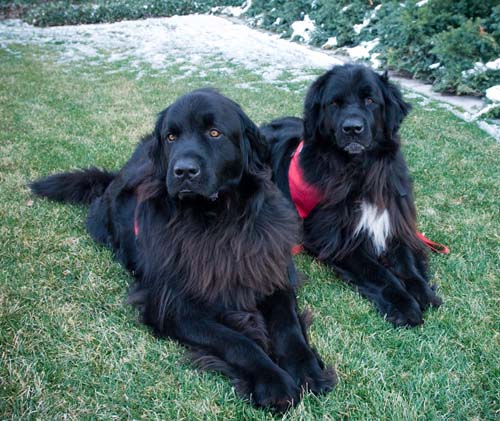
Sweetbay’s
Therapy, Service and Assistance Dogs
Dogs have been helping man for centuries. The
first written mention of an assistance dog was in the 1700s.
Alphabet books for children illustrated the letter B with “a
Blind man, led by a dog.” During the first World War, guide
dog training schools were established in an effort to aid
soldiers who were blinded during battle. Service work expanded in
the twentieth century, to include hearing aid dogs and physical
assistance dogs.
Formal therapy dog work began in the United States in the 1970s.
It started rather casually, thanks to people like the chaplain in
New Jersey who brought his golden retriever along as he made his
rounds through the hospital wards. Staff workers noticed that the
chaplain evoked an extremely positive response in the patients he
visited. But they saw it wasn’t the chaplain who brought
smiles to the patient’s faces; it was the dog. Bit by bit,
other informal visitations began to break down the “no
dogs” taboo. One of the first institutions to officially
open its doors to dogs was the Mayo Clinic, and one of its first
canine volunteers was a Newfoundland.
Many documented studies show that therapy dogs reduce stress and
lower a person’s blood pressure. They also raise the
patients’ spirits, a critical element in getting well. Over
the years, therapy dogs of all breeds have been welcomed in more
and more hospitals and care facilities across the country. But it
is hard to imagine a breed more ideally suited for this work than
a Newfoundland.
Every family’s Newfoundland is a therapy, assistance or
service dog to some extent. When you come home after a
particularly dreadful day at work, that Newf lays his head on
your knee and tells you it’ll be better soon. When a pair of
balled-up socks falls out of the overloaded hamper you are
carrying up the stairs, that Newf will pick them up and bring
them to you. When your arthritis flares up and you can’t
hoist yourself out of the couch, that Newfoundland will hold
rock-still, letting you grab on and pull yourself to your feet.
However, there are Newfoundlands who take that genetic calling to
a much higher level. They serve in hospitals or schools, care
facilities or nursing homes. They visit elementary schools,
libraries, museums and summer camps, and the entertaining
programs they present demonstrate their helpful skills to eager
audiences. Sweetbay dogs have served in these capacities from the
beginning. Whether their deeds are officially recognized* or
performed more privately, their contribution is enormous, and we
would like to recognize them here.
*In 2011, the American Kennel Club launched
a program to recognize the dogs who serve in approved therapy
programs. Dogs meeting the AKC’s requirements earn an
official AKC title, and may use the initials THD after their
name.
Brett and Rachael
Beasley
Sweetbay’s Kilimanjaro THD, NF-8223, EL-2200 and
Sweetbay’s Jett THD
Provo, Utah

Jet and Jaro
Brett, Rachael and their four
children added a cute fluffy Newfoundland puppy to their family
in May of 2002. He was eight weeks old, and they named him Jaro.
Four months later, Brett and Rachael were eating lunch at home
and idly watching television when a public service announcement
came on, introducing a local therapy animal organization. Brett
snapped to attention, riveted. And the more he heard, the better
it sounded. Volunteering would mean he could help his own
community, and spend meaningful time with his puppy.
A bit of research led Brett to I.T.A. (Intermountain Therapy
Animals), based in Salt Lake City. Brett says the decision to
call I.T.A. was one of the most momentous actions of his life. It
was pure chance that Brett caught that brief television segment,
but Brett’s interest became total commitment.
As Brett looked deeper into therapy work, he discovered that he
and Jaro already had accomplished some of the groundwork. Jaro
had completed a puppy obedience class, was halfway through
advanced training, and was poised to earn his Canine Good Citizen
certificate. In addition, everyone who met Jaro commented on his
love for people. He responded to everyone, and everyone responded
to Jaro. He was a people magnet, and he accepted the wide range
of human actions calmly and with quiet pleasure. That benevolent
nature was an essential asset in therapy work.
After noting I.T.A.’s requirements, Brett and Jaro brushed
up their skills and passed the rigorous tests to become a Pet
Partner Team. Jaro began working with I.T.A. in May of 2003.
Brett’s wife Rachael had also become a certified Pet
Partner, accompanying Brett and Jaro, or taking Jaro on her own
if Brett was unavailable. During his nine years of service, Jaro
happily shared his presence and his skills with an estimated 7000
patients, family, staff, and students, in a variety of facilities
far too numerous to describe.
Roughly midway in Jaro’s career, a second Newfoundland
joined the Beasley household. In 2007, Jett joined his big
brother and began making visitations. The staff members at the
hospitals and schools always brightened when they spotted the
“Beasley Boys” arriving for their sessions. As for the
patients, the two Newfs were nothing short of a marvel.
When Jaro and Jett donned their red therapy dog vests, they
became miracle workers. If you push him, Brett will set aside his
natural modesty and quietly recount stories that will overwhelm
your emotions. For instance, there was the day a young man in
nearly unbearable pain inched his way into a wheelchair so Jaro
could give him a “sled dog” wheelchair ride down the
pediatrics ward hall. Or the many young women who have since
graduated from a local eating disorders clinic. Those women give
credit to Jaro for helping them succeed in getting their lives
back in order – and in many cases, saving their lives. Then
there was the day Jaro ever so carefully eased his way onto a
patient’s bed on Christmas Day, giving the mentally
challenged gentleman the “puppy” he had always wanted.
The facilities Jaro and Jett visit are not lighthearted places.
Patients are frequently there for the long run, and many will
never get better or return home. The staff members work hard to
ease the patients’ stays, but treatments can be arduous and
hope is hard to come by. Brett smiles softly and says, “When
a patient is having a particularly hard time, the kind folks on
the staff know it. They recognize when a patient desperately
needs something to look forward to. That’s when I get a
phone call, asking if ‘the Beasley boys would make a special
visit today.’ And soon after, Jaro and Jett come strolling
in, with slowly wagging tails and broad grins, sporting those
cheery red vests, ready to share their gentle good spirits with a
friend in need.
Long-term care is equally hard on the patients’ families,
and Jaro and Jett lift their hearts as well. And there is no
question that the staff members receive an equal portion of
feel-good therapy while interacting with Jaro and Jett. The boys
definitely make the day a happier one for everyone.
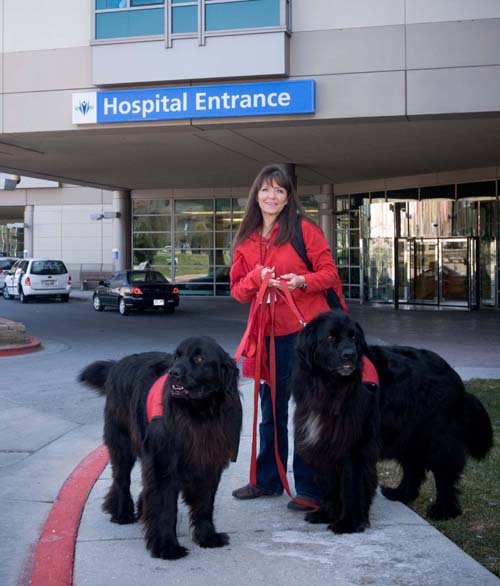
Jett, Jaro and
Rachael pause outside the hospital before beginning their rounds.
Lest you wonder whether therapy dogs enjoy their work, you only
have to watch the two Beasley Newfoundlands. When Jaro and Jett
enter a facility, the greetings they receive bring a bit of a
swagger into their steps. And oh, the tail-wagging! You could
sail a schooner in the breeze those happy tails generate.
Their biggest task, which they do phenomenally well, happens each
time they enter a room. They must sense the occupant’s
emotions and needs accurately and then respond in kind. The dogs
are far better at this than humans. They just know. Jaro and Jett
offer precisely as much interaction as the patient wishes. And
they are never wrong.
The Beasley Newfs visit many institutions on a regular basis, and
Brett is always happy to add new venues to the boys’
schedule. At each new facility, the staff and patients quickly
shift from “How ever do you tell them apart?” to
recognizing their individuality. Staff members proudly point out,
“Oh, that’s Jaro. He has the white blaze on his
chest.” Or, “No, that’s Jett – he’s not
quite as big as his brother.”
No one wants to be in a hospital over Christmas. Brett knows that
his boys can make the holiday brighter. Over the years, many
parents have stopped Brett or Rachael – it might be in
March, it might be in September - to give them a heartfelt hug.
Invariably, they will say, “You’re the parents of Jaro
Claus and Reindeer Jett! They came to visit our sick child in his
hospital room on Christmas Day, and none of us will ever forget
it.”
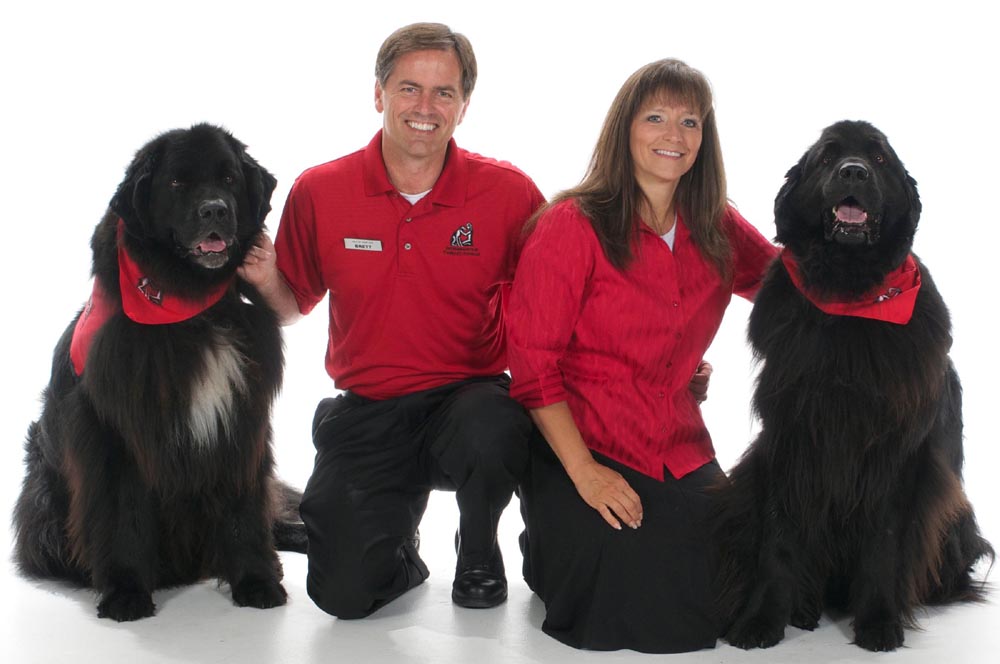
Jaro, Brett, Rachael and Jett
There is no doubt that one brief
television story on therapy work changed Brett’s life. His
association with his local animal therapy organization blossomed;
Brett moved from volunteer to County Coordinator and Team
Evaluator. He believes totally in the healing effect of the
human-animal bond, and his work with I.T.A. helps others partake
in the experience. As part of his job as county coordinator,
Brett gives countless speeches and presentations for film,
television, and print media. In every one, he emphasizes this
point:
“Every person we visit will soon forget my name, or
Rachael’s. But they will remember the moments they spent
with Jaro or with Jett, and they will know that the Newfoundlands
have made a positive difference in the lives of those they
serve.”
Brett is very modest about the Beasley family’s
accomplishments. But his unstinting efforts have greatly expanded
the therapy animal program in his area through his tireless
efforts to recruit stellar dogs and owners. Because of this and
many other contributions, Brett was recognized as I.T.A’s
2008 Hall of Fame Inductee. Which, being Brett, he immediately
downplayed. He insists that “This award does not go to me.
It goes to Jaro and Jett. They are the true volunteers.”
The Beasley Boys created a legacy that is being carried forward
by the newest member of the Beasley family, Jagger. He joined the
Beasley family in February, 2014, and the Beasleys continued the
socializing and training that had begun at the breeders’.
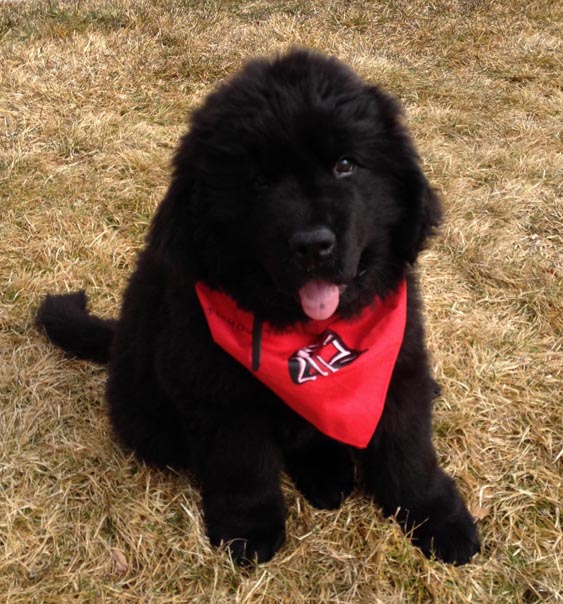
Jagger, eight weeks old, in his red ITA bandana
Brett will tell you that Jagger is his very own self – and
that he is a lovely combination of his two older brothers. He
clearly has Jaro’s personality. Jaro was much like Ferdinand
the Bull, enjoying every minute of every day while life passes
serenely by like clouds on a breeze. Virtually nothing fazed Jaro
– a critical trait in a service dog - and Jagger shows that
same nature. Jett, on the other hand, was all about intellect,
constantly exploring and figuring things out. This let him
instantly tune into a patient’s feelings, identifying his
mental state and physical condition. Jett absolutely understood
what they were feeling. Jagger also shows those same instincts.
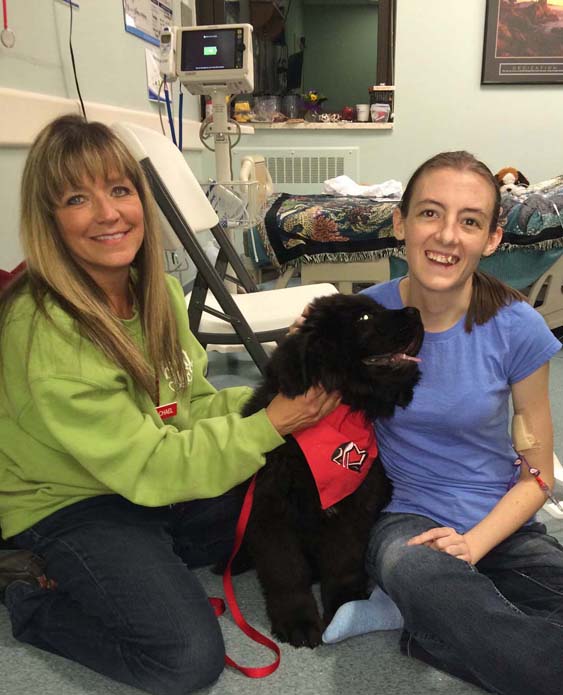
Rachael brings Jagger to visit a special patient.
One of the most difficult aspects of training and evaluating dogs
for therapy work is predicting which dogs will display the
necessary neutral reactions to other animals at any time and in
any setting. Over and over, a seemingly well-suited Pet Partner
team fails to make the grade because the dog is overly playful or
aggressive when another dog shows up on site. Jagger,
fortunately, has shown a balanced personality, and he
demonstrates good etiquette when he meets other animals.
The local hospital where Jaro and Jett performed much of their
service work made Brett and Rachael an unusual offer. They
invited Jagger to visit the hospital throughout his puppy life.
Since he is not yet certified to meet with patients, he meets
with the staff. They are always delighted to see Jagger. And
these monthly visits allow Brett and Rachael to observe and
evaluate Jagger’s progress. At Jagger’s last visit, a
senior administrator voiced what they all had observed.
“He’s a natural.”
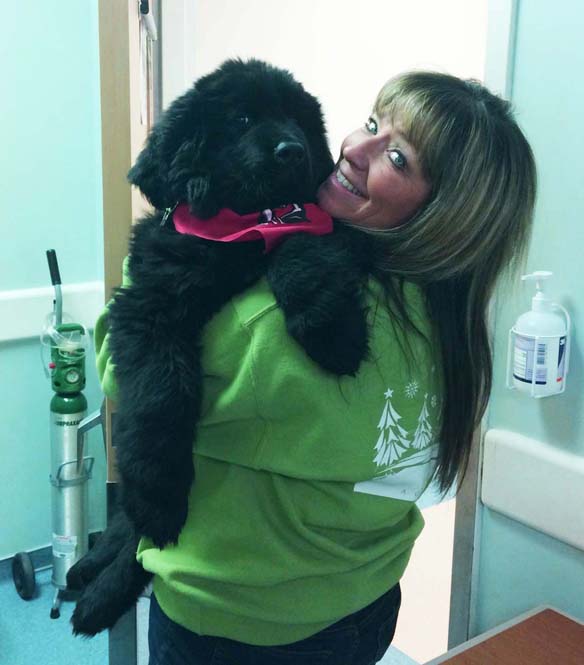
Jagger and Rachael
Jagger is well on his way to following in his big brothers’
footsteps. He will be eligible to register as a Therapy Animal
early in 2015.
Patti and Veronica
Pigeon
Ch Sweetbay Sullivan RN WD DD, EL-4795 and
Sweetbay’s Lola, NF-9522, EL-3267
Golden, Colorado
Denver’s Craig Hospital
provides care and rehabilitation for patients with brain or
spinal injuries. For many years, members of Colorado’s High
Country Newfoundland Club have brought their dogs to visit the
patients. Monday night is “Newfie night” at Craig, and
anywhere from two to six Newfoundlands saunter from room to room,
stopping in to say hi to each patient who wishes a visit.
For the Pigeons, visits to Craig are a family affair. Patti
Pigeon is a regular, bringing her two-year-old Sweetbay’s
Sullivan. Patti’s husband Paul accompanied Patti for
Sully’s certification. Patti’s daughter Veronica Pigeon
“dognaps” seven-year-old Sweetbay’s Lola from her
twin sister, Nicolette Reynolds, for these visits – and
sometimes Nic’s husband Kevin comes, too.
Sully and Lola visit Craig together. Each is a natural at therapy
work, but they have very different styles – and together,
they make a perfect team. Sully is outgoing and gregarious, the
life of the party, and he is quick to recognize which patients
will enjoy a visit from an exuberant force of nature. His joie de
vie and that ever-wagging tail can quickly shift a depressed
patient into one who grins and laughs. Lola is a more reflective
Newf. She calmly eases into a room, taking the measure of its
occupants, waiting quietly until she’s invited over. She
reads people intuitively, and always knows which ones would
prefer a soft head to quietly pat or a furry body to gently hug.
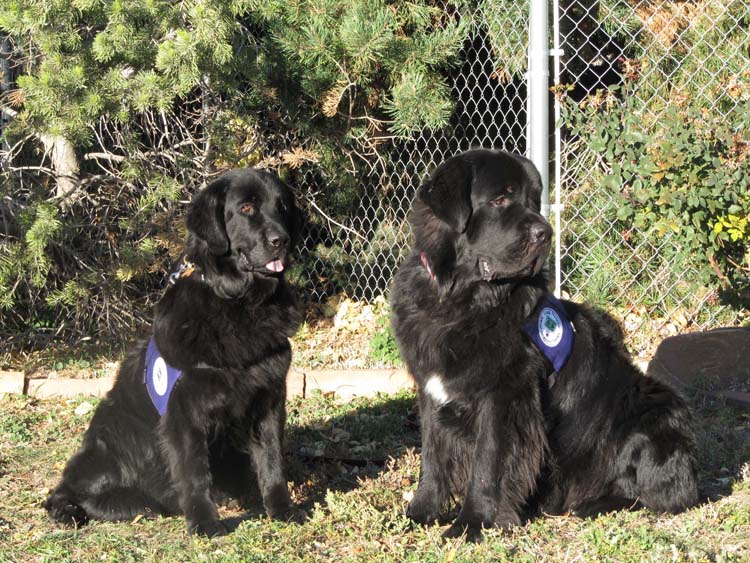
Lola (left) and Sully pose before their weekly hospital visit
Craig Hospital has two floors that
house its patients. One floor is for those who are severely
compromised. They are frequently unable to walk or talk, and are
often on ventilators. The second floor houses the more active,
capable patients. Each Monday night, the Newfs visit every room
on both floors. (Patti and Veronica always ask permission to
visit, knocking politely on each door, but the answer is
invariably a delighted “yes!”) Each room is actually a
mini-suite, occupied not just by the patient but by family
members and friends. In some cases, the patient might be reticent
to visit a dog, but the family members are always delighted to
see the Newfs.
Petting or hugging a dog is often a formal part of a
patient’s physical therapy. For many patients, just being
able to reach their hand out to touch a dog’s head is a real
challenge – but it’s oh so worth the effort, because
there’s a vibrant, beaming dog involved, and not a cold
clinical piece of machinery measuring their progress. When family
members provide encouragement, and a dog asks with its gleaming
eyes to be petted, patients work hard to make the effort.
Patti reflects on their Craig visits with a smile.
“It’s really great to be able to give the people a
break in their day. At Craig, it’s all institutional –
it’s a hospital, after all – and everything around the
patients is intense. But when the Newfs arrive, everything
changes to warm and fuzzy.”
“It’s true,” says Veronica. “When we’re
in a room visiting, the patients will relax and smile. They get
so excited to see us. I love when they share interesting stories
about their lives before they became incapacitated. Their days
have become so clinical at the hospital, but the dogs’
visits are pure joy. The patients can forget their troubles for a
while and just have fun.”
To be eligible to visit Craig Hospital, Patti (and Sully) and
Veronica (and Lola) had to pass a TDI test. Therapy Dogs
Incorporated sets the standard for appropriate therapy dog
behavior, and Sully and Lola passed with ease. Once approved, the
dogs went through a short probation period. A TDI tester observed
their first three hospital visits, and the positive reports
shifted them to official therapy dog status.
Holiday visits are especially fun. Every December, the Newfs don
Santa hats. And for Halloween, the sky’s the limit. In 2012,
Lola was a flamenco dancer, with a gorgeous red and black slinky
dress and a dramatic tulle rose tucked behind her ear. Sully,
ever the clown, was a giant rabbit, complete with long fuzzy grey
ears that flopped down over his nose, and he carried a giant
stuffed carrot. As Patti says, “Everyone loves dogs in
clothes. And Sully and Lola love dressing up. When the costumes
come out, they get even more excited. They love their Craig
visits.”
Pat Nevils
Sweetbay’s Galileo, NF-8283, EL-2252
Houston, Texas
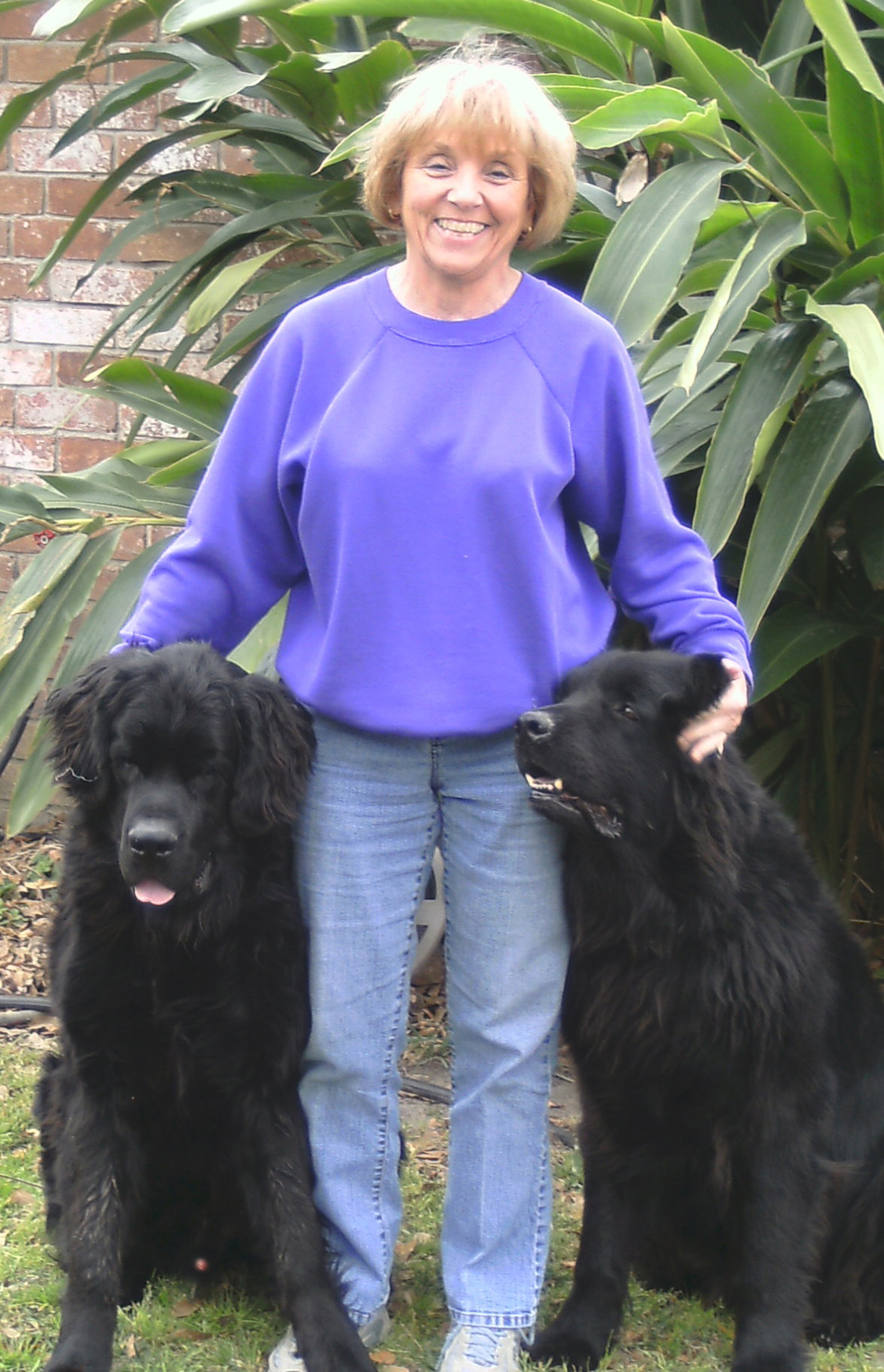
Pat Nevils is flanked by Ike (left)
and Leo
Pat Nevils is the rescue chairman for Old West, the regional NCA
Newfoundland club based in Texas. Dozens of abandoned or unwanted
Newfoundlands have come into her home on a temporary basis,
usually with short or no notice. Pat welcomes them, lives with
them, assesses them, gives them great care, and works hard to
find them marvelous, permanent homes.
Pat has one Newf of her own, Sweetbay’s Galileo. Leo helps
Pat with the new dogs, teaching them the ropes and quietly
helping them settle into the Nevils routines for the duration of
their short stays.
In October, two weeks after Hurricane Ike wreaked its devastation
on the south, Pat received notice of a male Newf who had been
found wandering, homeless. He was clearly one of the many victims
of the hurricane. Pat took him in and promptly christened him
“Ike.” Nothing was known of his history. He was
underweight, dirty, tick-infested, and obviously uncared for, and
his general appearance, serious demeanor, slow movement and
unsteady gait put his age at around six. When Pat took him to her
veterinary clinic for an evaluation, the veterinarian provided
surprising news: the dog was closer to two years old. Ike’s
impaired movement and lack of balance was not due to advanced
age. As the veterinarian discovered, Ike had cataracts and was
virtually blind.
This is where Leo comes into the story. Ordinarily, Leo remains
calmly and emotionally neutral from the rescues that come and go.
He knows they’ll stay only a few days, then move on.
He’s gentle with them, welcomes them, but does not get
deeply involved. But when Ike arrived, Leo’s behavior
totally changed. He seemed to instinctively know that Ike was
lacking a crucial faculty, and that the big shambling Newfie
needed him. Leo greeted Ike very gently and allowed Ike to sniff
him all over. He continually checked on Ike, and was very patient
with the big, quiet boy.
Since Ike cannot see, he relies on touch. Leo allowed Ike to stay
in physical contact whether they were lying down, waiting for
their dinner, or roaming the back yard. Many times, Ike crashed
into Leo if Leo slowed down or stopped. That’s annoying, but
Leo never corrected him. Instead, he waited for Ike to figure it
out, and Ike either backed up so he was touching Leo, or put out
a paw to maintain contact.
Indoors, Leo showed Ike all the important places: the cool foyer,
the kitchen, the bathroom, and he helped until Ike could navigate
on his own.
Leo also tried to show Ike how much fun life is – but Ike
had no idea how to play. He simply had never done so before, and
was clueless. Leo was endlessly patient, and in time, Ike gained
enough confidence to begin to play. Leo taught Ike to run beside
him. This meant the normally zooming Leo had to “run”
very slowly, for Ike’s slow shuffling gait would never
improve. Leo also taught Ike a version of “chase” that
they could play, with Ike pursuing Leo in the safety of the back
yard. Next came hide and seek. Leo would move away and then hold
very still, smiling and wagging his tail as Ike took a minute or
two to find him.
Leo has a favorite outside toy, a “ball within a ball.”
It brings out his puppyish nature, and he rolls it about with his
nose and feet, barking at it with glee. He convinced Ike that
this was the best toy ever, and shared it politely. Then he
taught Ike how to play with it. Ike now bashes it about the yard
like a soccer player, nudging it with his feet until it gets
stuck at the fence corner, then picking it up and carrying it to
the middle of the yard to start again. It would make you smile to
watch them together now, for Ike truly did not know how to play
until Leo taught him how.
There have been many adjustments along the way for Ike. Getting
him into a car was a huge challenge at first. He was afraid to
get his feet off the ground. Leo, of course, loves car rides, so
he demonstrated how to jump in and out of Pat’s SUV. His
enthusiasm diminished Ike’s fears, and Ike now confidently
puts his front feet up so Pat can boost him in.
Leo has always loved draft work. He was a natural from the
beginning. Pat wondered, could Ike learn to pull a cart if he was
hitched in tandem with Leo? Newfies love having a job, and this
might be a safe and enjoyable activity for Ike. Sure enough, with
his best friend Leo by his side, Ike took to carting and enjoys
the activity.
Every rescue dog that Pat brings into her home is there only
temporarily. It is a pact Pat has made with herself: each will be
placed with a loving, permanent family. But Ike may be the
exception, and it’s all because of Leo. Ike’s vision
issues necessitated several veterinary-specialist visits. When
that first appointment rolled around, Leo watched Pat and Ike get
into the car and drive off. Leo’s face and attitude showed
his usual stoic acceptance of the way the world is. This was just
like always: a dog comes, stays, and then leaves, never to
return. After all, every other rescued dog had come – and
then left.
Hours later, when Pat’s car pulled back in the drive, Leo
greeted her with a wagging tail. But when he saw Ike in the car,
he literally bounced about, airborne, jumping with joy. You could
just see him saying, “Ike! You’re back! I’m so
glad you’re back!” It was totally unlike Leo’s
response to any other dog Pat had taken in. There was no
question: these two were soul mates.
And if you ask Pat if Ike will be going to a new home sometime
soon, she just shares a smile with Leo as she shakes her head.
Ike is their boy now. He absolutely trusts Leo in every way. The
fearful dog who came to the Nevils household in October of 2008
is now a confident and happy boy, thanks to his relationship with
Leo.
Theresa Kelly
Sweetbay’s Koda, NF-9985
Bellevue, Nebraska
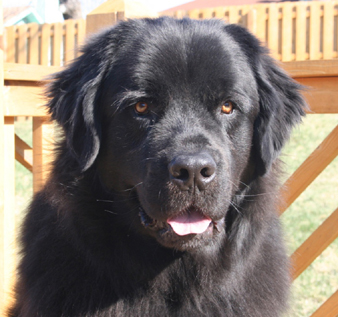
Koda
Theresa Kelly fell in love with Newfoundlands for the usual
reasons: they are beautiful, sweet, and intelligent. But she had
an even more compelling reason for choosing the breed. Her
husband, Dan, has physical limitations and reduced mobility. A
well-trained service dog would be of inestimable help in
improving his quality of life. But rather than purchase an
already-trained dog, Theresa wanted to start with a puppy - a
Newfie puppy.
Before the puppy arrived, Theresa searched for a service trainer.
Living in Nebraska, she wasn’t optimistic of her chances. So
she was delighted to find a woman who did search and rescue and
who trained service dogs as a sideline. Theresa telephoned,
introduced herself to the woman, and explained her plan.
To Theresa’s surprise, the trainer stated flatly that a Newf
was a lousy choice as an assistance dog. In her words, they are
all “big, clumsy and lazy,” and she pointedly suggested
that Theresa choose a more suitable breed. Theresa, however,
refused to be dissuaded. She had her heart set on a Sweetbay
puppy, and was positive she could make it work.
The trainer became even more adamant about her reservations. She
told Theresa that good service dogs begin their training from
birth, and she stressed how far behind the puppy would be. So
Theresa explained about the extensive socializing and training
all puppies receive at the Adlers’, adding that they were
bred for intelligence and working skills which should help. She
could tell, though, that the trainer was shaking her head and
thinking, “Yeah, right.”
The trainer informed Theresa that there was more to assistance
work than just obedience training, and the dog must have a
certain attitude. “You can’t just take any old puppy
and make it a service dog,” the woman kept repeating. Then
she offered to provide Theresa with a “better” dog. But
Theresa knew the Sweetbay puppy she would be getting was a far
cry from “any old puppy.”
Even though the trainer clearly had already made up her mind, she
grudgingly offered to accept Theresa and the puppy as students on
a trial basis. Theresa thought long and hard. She realized that
the trainer’s opinions were just that: opinions. She
didn’t have to buy into them. But she could still learn, and
the puppy would benefit from the training. Theresa decided to
hold her tongue, ignore the woman’s negative opinions, and
let the puppy prove its worth.
When Koda arrived, age eight weeks old, it was clear that he was
an extremely well-socialized puppy with a confident, happy,
curious nature. Theresa began teaching him some baby basics, and
she continued his socialization, taking him for car rides and
introducing him to everyone they met along the way.
A week later, Koda and Theresa had their first service training
session. The trainer came to the Kelly house, her negative
attitude in full bloom. Koda was playing in the kitchen when the
trainer came in. She purposely ignored him, interrogating Dan and
Theresa instead, all the while subtly observing Koda. Getting no
response from her, the friendly pup went about his business,
playing with his toys. Theresa answered her questions, explaining
about Sweetbay and the Adlers’ dedication to producing a
strong line of working dogs. She shared the information packet
the Adlers had sent, and the trainer was surprised at the amount
of information Theresa had about Koda and the details of his care
up to that point.
Then she turned her attention to Koda. When she called him, he
excitedly ran over and immediately sat down in front of her to
greet her, retaining that sit as he wriggled with happiness. The
trainer was clearly surprised at his manners, his speed, and his
enthusiasm.
She was still sure he would be critically far behind, though.
Theresa watched nervously as the trainer gave Koda a series of
commands. As he responded perfectly to each one, Theresa looked
over at Dan and they both smiled. Koda continued to perform
beautifully, no matter what the trainer tossed at him. Koda even
performed commands Theresa didn’t realize he knew.
But the trainer wasn’t yet ready to be won over. Despite
Koda’s stellar performance, she offered only one comment.
Koda didn’t maintain constant eye contact with her, and that
was a bad sign. Theresa smiled to herself and thought,
“Well, it can’t be that much of a problem since he
responded to all of your commands correctly and easily.”
Then the trainer escorted Koda outside in order to test a few
more behaviors. Again, Koda performed each command without
hesitation. The Kellys couldn’t have been more proud of him.
He even outshined their expectations.
Finally, something verging on the positive came from the
trainer’s mouth: “He definitely likes to work.”
When the session was over, Theresa asked the trainer what she
thought. “There is a lot of work to be done with Koda,”
she said - and then added “But he does appear to have a
fairly good start.” Theresa just smiled. He had made a good
impression on her, but she wasn’t ready to admit it.
Koda lost no time in winning the trainer over. Over the next
several sessions, he learned dozens of behaviors, performing each
one with joy. He accepted his service dog cape and collar without
demur and wore them proudly.
On many occasions, the trainer would try to startle him into
inappropriate responses like running away or behaving fearfully
or aggressively. But sudden loud noises and scary actions were
not a problem. Koda met them all calmly and with interest.
It was clear the trainer recognized Koda’s potential. She
did mention, though, that she would have to adjust her usual
training methods as they went further into the training, since
“Newfs are totally lacking in physical agility.” Dan
and Theresa just smiled, knowing that this was just one more
misconception that Koda would joyously shatter.
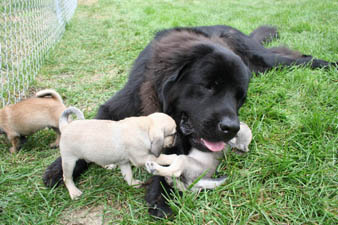
Koda’s gentle
nature makes him a natural for therapy work
P.S. Three years later, Koda has more than proved his worth as a
service dog. Oh, and you know that little vest he wore when he
first started learning the ropes? Well, rather than equip him
with a big-dog version, the Kellys chose a sturdy backpack for
his service clothes. As Theresa says, there’s one big
advantage to choosing a giant breed for your service dog:
there’s lots of storage room for all the stuff an owner
might need.
Lois Apfel
Sweetbay’s Cimarron CD TD WD, NF-5789, EL-608
Lakeside, California

Cimi
When Lois Apfel heard of a program where gentle dogs visit the
library to encourage young children to read, she knew that would
be a perfect job for her therapy dog, Cimi. Her local branch of
the San Diego county library system inaugurated their own program
in 2003, and the library staffers welcomed Lois and Cimi with
delight.
Reluctant readers soon became eager readers thanks to Cimi’s
calm presence. An adult or other child could be intimidating or
might tease, extinguishing even a tiny spark of willingness, but
Cimi was nonjudgmental. His quiet interest encouraged the child
to try, and reading out loud became possible and then fun. Week
by week, Cimi sat with his individual charges and listened to
book after book. Even now, Lois hears from parents who comment
about what a big difference Cimi made in their young sons’
and daughters’ lives.
Rick Pourchot
Sweetbay’s Olivia CDX THD WRDX, NF-8222, EL-2199
Ballwin, Missouri
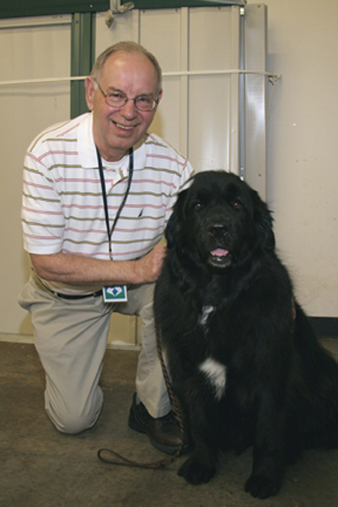
Rick and Olivia
Rick Pourchot took his Newfoundland, Olivia, through the therapy
dog training program sponsored by Support Dogs Inc. This is a St.
Louis-based non-profit agency that provides service dogs to
recipients nationwide as well as pet-assisted therapy to
thousands in the St. Louis metropolitan area. Olivia graduated on
May 1, 2008, with flying colors. She was certified AC2 for
“adults and children,” which allows her to visit
specialized school districts in addition to hospitals and nursing
homes.
There were six dogs present at Olivia’s first assignment, at
one of the special school districts in St. Louis. The students
ranged from age 13 to 21. The dogs worked in pairs, moving from
room to room, accompanied by a staff member. Rick recalls that
first visit lasted with a smile. It lasted an hour and there was
never a moment without at least one hand touching Olivia, and
usually many.
Students who were capable of movement would reach out and pet
Olivia. The students who lacked motor skills would turn their
heads in her direction, and Olivia would instinctively move in
close so they could make contact. Knowing that this was great
physical therapy, the staff member would encourage those students
to “Turn your head in this direction so you can see this
beautiful dog.”
The last students Olivia visited were more advanced in their
abilities, and they were able to go outside. They took turns
throwing a ball for her, and she fetched and fetched and fetched,
delighting them all.
During the ball-playing session, the other therapy dog brought
his ball over and lay down next to Olivia, quietly content. His
owners were amazed; they said their dog would not let any other
dog near him when he had a ball. Olivia’s quiet, responsible
demeanor had worked on her co-therapy dog as well as it did on
the children.
Olivia also visits the Veterans’ Hospital on a regular
basis. She is a big hit with the men, and they look forward to
her visits.
In September, Olivia was accepted into the PAWS for Reading
program, and made her first visit to meet her class. The school
is for students with multiple learning disabilities, and there
are ten students (ages seven and eight) in Olivia’s class.
This was the first time a dog was invited to the school, and the
students were really excited. Before the visit, the students
wrote a pledge where they promised to treat Olivia with respect.
During her visit, each student recited the pledge to Olivia
before they read to her from a book of their choosing. The rules
were both sweet and common-sense; they included “pet the dog
softly” and “do not step on her.”
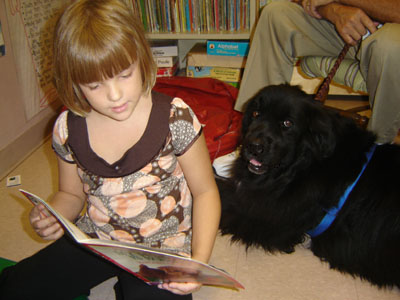
Olivia at work
In December Olivia was again tested, and she earned the highly
coveted and difficult-to-attain AC1 certification. AC1 is given
only to the best of the best. It qualifies Olivia and Rick to be
one of sixteen dog/handler teams who volunteer at St. Louis
Children’s Hospital. As an official hospital volunteer,
Olivia can be seen making her rounds in the Pediatric and Cardiac
Intensive Care floor and Hematology/Oncology/Bone Marrow
Transplant unit. As she visits with the kids, Olivia brightens
the day for the doctors, support staff and the patients’
parents as well.
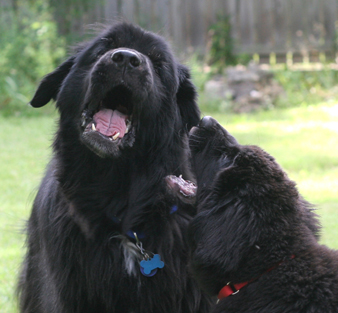 :
:
Olivia enjoys a play
session with the Pourchots’ young puppy, Zara
From the time she was a tiny puppy, Olivia was an extremely
observant dog. She always noticed when something was different in
her surroundings (a birdhouse newly hung from a tree, an open
window, a new toaster in the kitchen, a towel hanging on the
fence) and she always had plenty to say about it. Yet when she
does her therapy work, nothing whatsoever bothers her. Special
needs children can be very loud and shrill, not to mention
erratic and unpredictable. And every schoolroom, hospital ward,
and nursing home brings a wealth of new experiences. But Olivia
just accepts it all with quiet calmness.
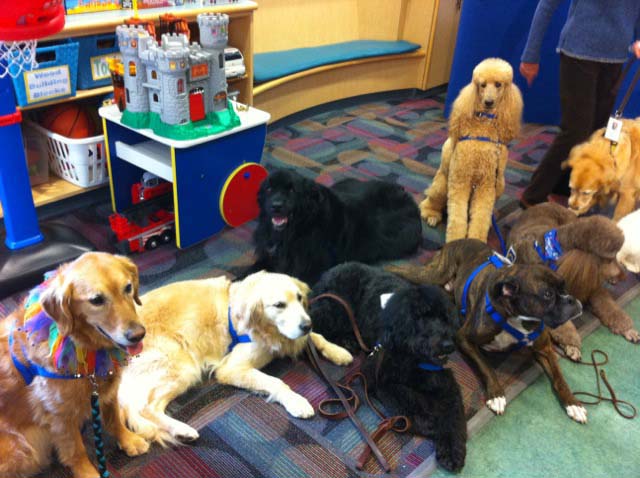
Rick Pourchot’s
Olivia (back row, center) takes a break from her therapy duties
at the Children’s Hospital and poses with her fellow service
dogs
Karen Brockway
Sweetbay’s Ellie, NF-9695
Bend, Oregon
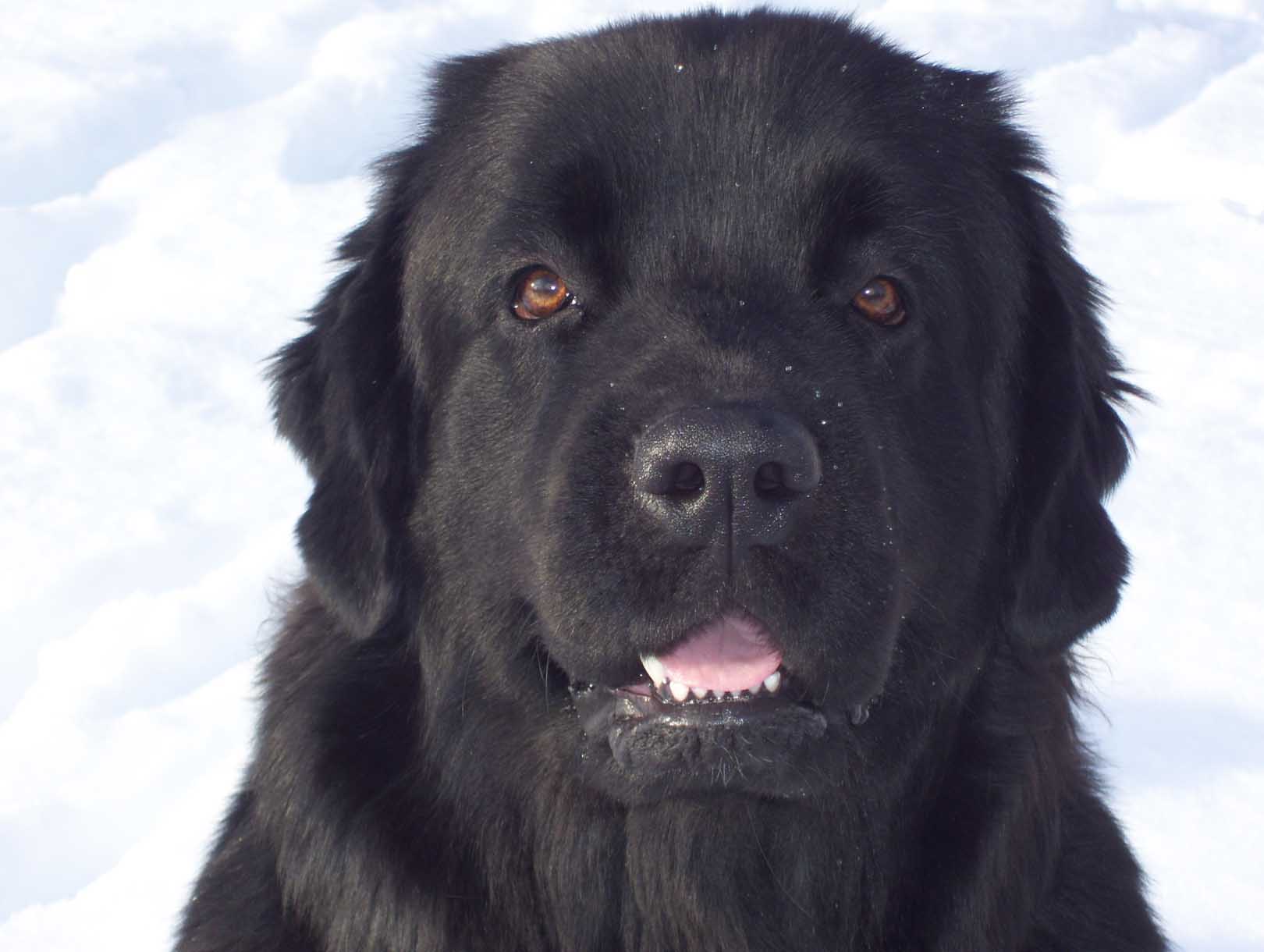
Ellie
Karen Brockway has had Newfoundlands since she was a teenager,
back in the 1970s. A marriage followed by the arrival of a son
and daughter sent her life in a new direction. She began
volunteering at her children’s school, taking on various
jobs there, both volunteer and paid. That rekindled an interest
in teaching. So after a seventeen-year break, Karen went back to
school. Five years ago, she completed a bachelor’s degree in
human development, and in the fall of 2005, she began teaching at
M.A. Lynch, an elementary school in Redmond.
Schoolrooms often include a class pet, typically a gerbil, bunny
or guinea pig. But Karen had always thought it would be great to
have a dog as the classroom pet, so she set out to make this a
reality. Her Newf puppy, Ellie, was four months old when Karen
approached the principal with her idea. Karen was midway through
her first year as a teacher, and she quite frankly expected to be
met with resistance. But she hoped that if she was polite,
patient, and persistent, her dog could eventually win a place at
school.
Karen’s first-grade class consisted of 26 students who were
high on energy but low on the traits that make for successful
students. Karen calls them “high-octane” kids. The
school is situated in a low-income part of town, and many of the
kids lack a stable home life. Most had never had a pet, and had
never known the unconditional love that a great dog can provide.
Karen was positive that Ellie could make a difference in these
kids’ lives. Amazingly, her principal listened to the
proposal and agreed to give it a try. Ellie would make her debut
in April, 2006, just after spring break.
Newfies are irresistible, and Newfie puppies are doubly so. Karen
knew her two dozen energetic first-graders would overwhelm the
puppy, swarming around her and swamping her with petting hands
and loud chatter, unless Karen set some firm guidelines. So she
prepared for Ellie’s first day in several ways. She also
wanted the students to know that Ellie was there to do a job, not
just to be petted or fussed over. Service dogs wear vests to
alert the public that they are on duty, and Karen decided that a
bandana would serve as Ellie’s “work clothes.”
When the kids saw Ellie wearing a bandana, that meant they were
not to pet her or call her by name. (Waving hello is fine.)
Karen also set up a crate in the classroom in a relatively quiet
spot. That area was designated as Ellie’s “office”
and the crate was her “desk.” Karen knew the puppy
would appreciate a place she could go when she needed her own
space. Hand-printed signs designated these areas as Ellie’s,
and the kids respected them. (This worked even better than Karen
had imagined. Although the crate door was always left open, the
first graders quickly understood Ellie’s need for a bit of
quiet time now and then. Many times a day, two or three kids
would be sitting just outside the crate, quietly reading to
Ellie.)
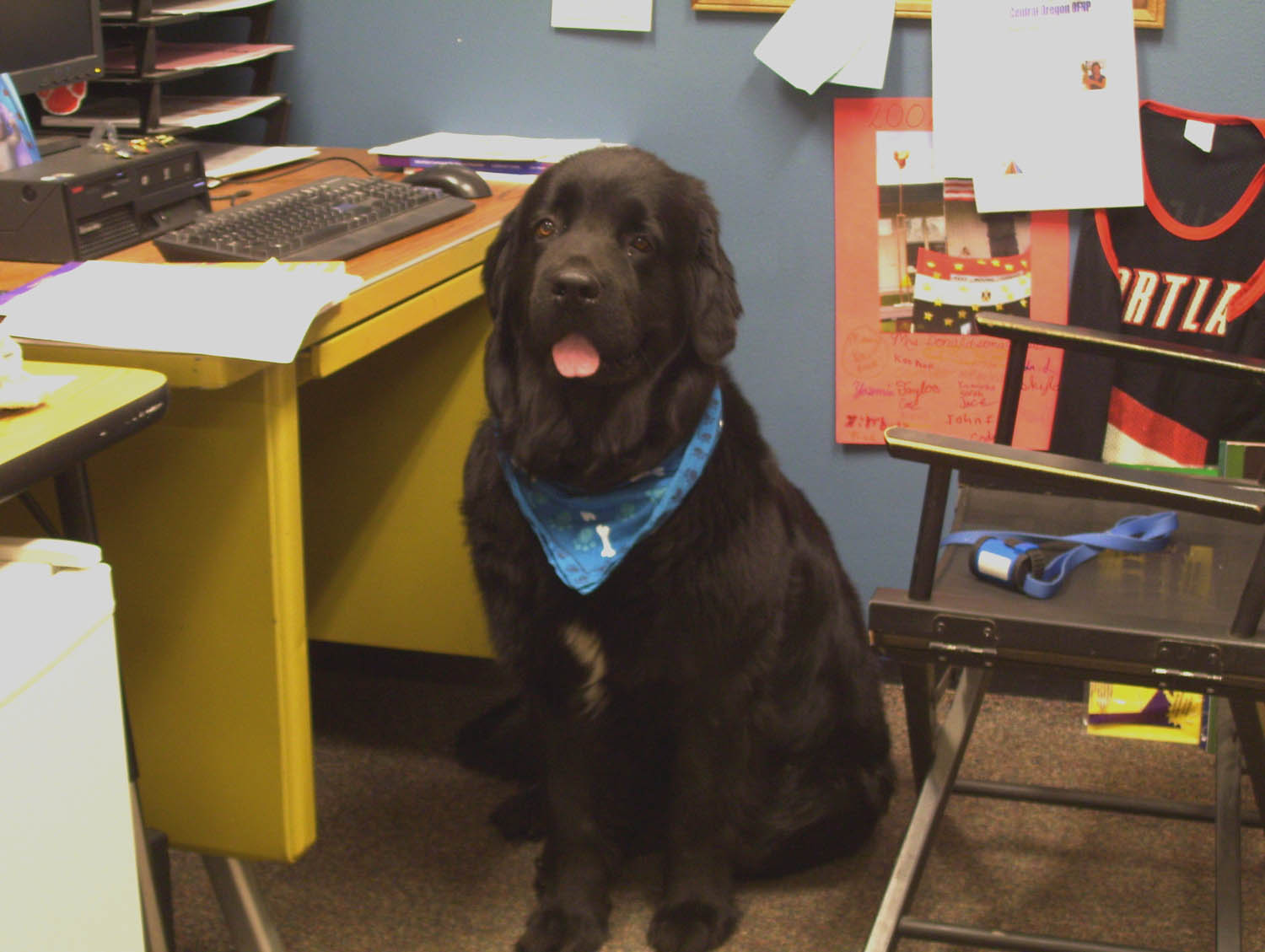
Ellie poses in her
bandana
Since Ellie was just a pup when she began coming to school, in
one way she was in the same boat as the students. She, too, had a
lot of learning to do. This meant mastering basic commands as
well as fitting into the daily routine at school. Karen told her
first-graders that Ellie, too, would be learning, and that she
needed the students’ help. The majority of Ellie’s
actual training occurred during school hours, and the kids were
always in Ellie’s corner, helping her to succeed.
Fortunately, Ellie learns quickly and loves to please. Throughout
the school year, the students learned important lessons about
consistency and clear communication by watching the puppy learn
her lessons.
Before the school year began, Karen sent out a letter to the
parents of her students, informing them that Ellie would be in
the classroom, and asking to be notified of any pet allergies or
concerns. Those were worked out on an individual basis. The
principal was Ellie’s staunch supporter. Rather than ban her
from the school, he simply assigned the affected child to a
different classroom. Not that there were many who objected that
first year. Ellie quickly became a well-known beloved part of the
school, and now, virtually every incoming student fervently begs
to be assigned to Ellie’s class.
At school, Ellie vastly exceeded everyone’s expectations.
Her presence in the classroom provided an immediate calming
effect. From the first day she came to school, the octane level
in the room immediately decreased dramatically. It wasn’t
anything Karen did; it was just Ellie’s calming presence
that settled the kids down.
That the first day of school, Karen began by making
introductions. She told the class some basic facts about Ellie,
as she knew the kids would be curious. She pointed out
Ellie’s desk, and informed the kids that Ellie would
probably take a nap or two during the day. She added that Ellie
snores when she sleeps, and not just a quiet little ladylike
snore, either.
The kids all laughed at that. The concept of a dog snoring was
beyond them. But Ellie is, indeed, a prodigious snorer. And the
first time the kids actually heard her, the look on their faces
was priceless. Ellie’s snoring became a class legend, and
the students treasure this as their own private secret. Since
Ellie’s desk isn’t immediately visible as one enters
the classroom, visitors have no idea that there’s a dog in
the room. And on several occasions, a visitor has walked in,
heard Ellie’s snores, and stopped dead, totally stumped at
what was causing that strange racket. The kids try their best to
keep straight faces, but they can’t contain themselves for
long, breaking out in laughter at the visitor’s
befuddlement, and full of pride because they know the secret. It
is a definite ice-breaker!
Since Karen knew she couldn’t stop Ellie from snoring, she
used it to her advantage. If her first graders became a little
too rowdy, she would tell the kids that “we don’t want
to disturb Ellie’s nap.” It was truly amazing, how
quickly they calmed down. As long as Ellie snored, the kids were
quiet, and anyone who began to act up would be greeted by his
fellow students saying, “Shhhh, Ellie’s sleeping!”
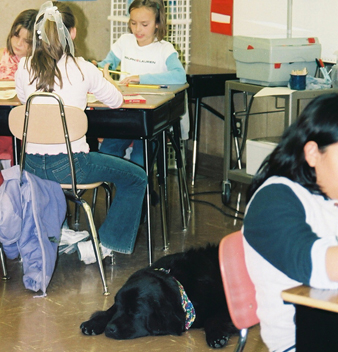
Everyone settles
down when Ellie settles in for a nap.
One little boy in Karen’s first grade class had a very
unhappy home life. Somehow, Ellie always knew when he was having
an especially bad day and she would spend the majority of the
school day by his side. She not only helped him, she let Karen
know when he was having a rough time and needed extra
understanding and patience. Throughout her years at school, Ellie
continues to know which children need attention, and she calmly
and quietly supplies it as needed.
Many of the students struggle with reading. They found they could
triumph over their frustrations simply by reading to Ellie. This
became a special treat, being able to read to the Newfoundland,
and the students’ good behavior was rewarded with reading
sessions. Reading is a privilege, and they all wanted their turn
with Ellie. (Even after they graduated and became second, third
and fourth graders, they still loved taking turns reading to
Ellie.)
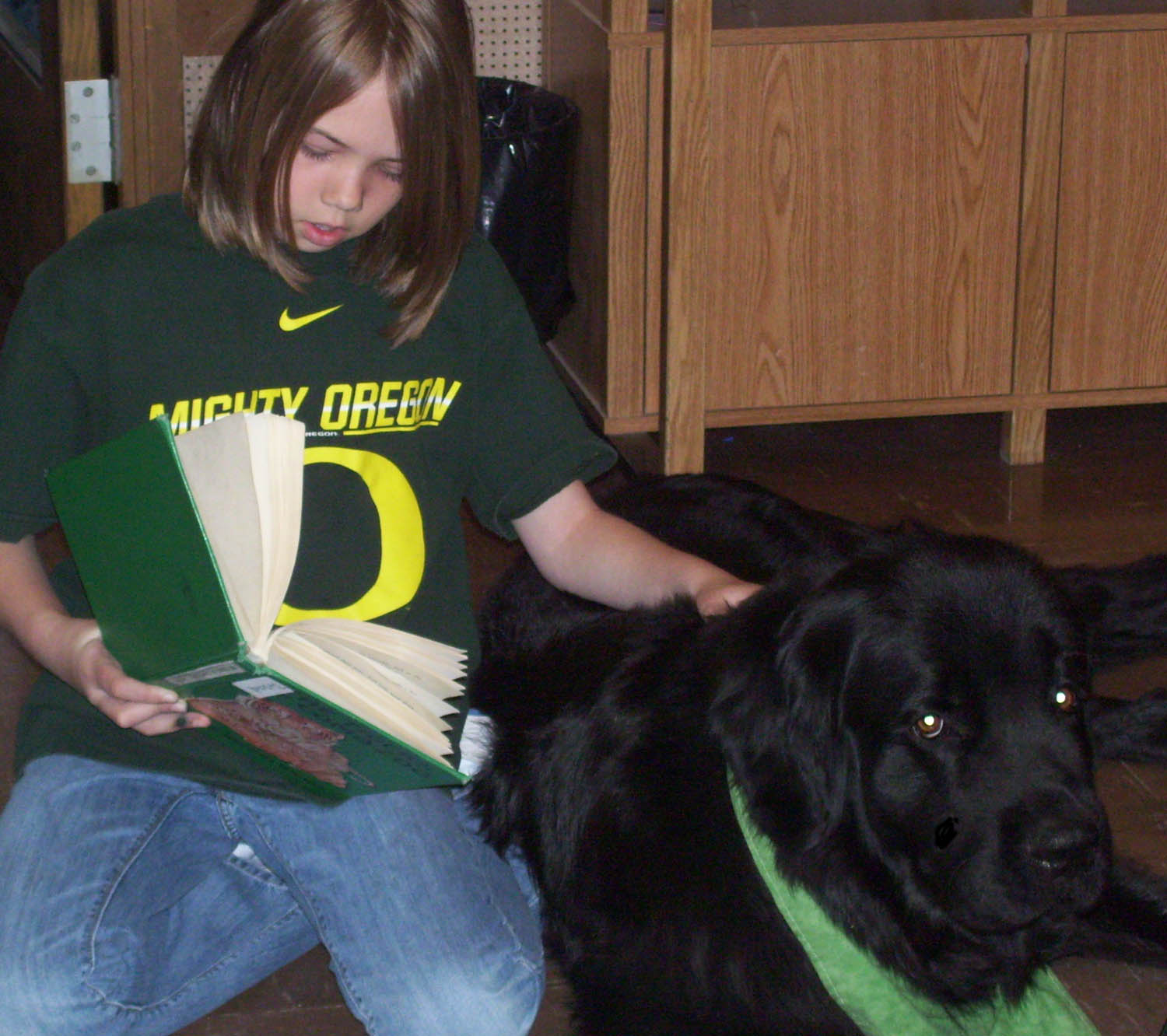
Ellie listens
patiently as a student works through the text. That hand on
Ellie’s shoulder seems to ease the reading along.
You can’t help but notice that Ellie’s reach extends
beyond Karen’s first-grade class. One fifth-grader had
always struggled with the daily routines and interactions, and
his teachers had a tough time motivating him, holding his
interest, and keeping him on a steady keel. He was introduced to
Ellie at the start of the year and they formed a bond. Now, he
asks for permission to visit her when he becomes overwhelmed, and
this has helped him settle into the school routine.
One day, his teacher had the class write a poem. The boy
struggled over the assignment, then expressed his frustration by
acting up. At a suggestion from his teacher, he brought his paper
to Ellie’s office. With Ellie sitting at his side, within
minutes he had completed the assignment. Karen quietly watched
from a distance as the boy wrote a sentence, gave Ellie a treat,
wrote another sentence, gave Ellie another treat, and so on,
until he had a full poem. Being with Ellie, and being able to
give her a treat for each line he accomplished, calmed him down
and allowed him to do the work. The pride in this young
man’s face as he handed over the finished poem was something
Karen will always remember.
Ellie’s presence also works wonders on the school staff.
Each morning, she announces her arrival with a series of Newfie
barks and yodels, and everyone who hears her breaks into a grin.
You can hear them saying, “Ellie’s here!” with joy
in their voices. When Karen walks her down the hall, Ellie
saunters saucily, her tail wagging and a big grin on her face,
and her upbeat behavior elicits smiles from everyone in her
vicinity.
During Ellie’s first weeks at school, Karen visited the
other classrooms, introducing her bandana-wearing puppy and
explaining the “Ellie protocol.” The kids who already
knew Ellie helped spread the gospel, too. On many occasions,
Karen would overhear some student politely inform another
student, staff member or visitor, “Ellie’s wearing her
bandana so you can’t pet her right now.”
Ellie is naturally suited for her classroom work. She truly loves
going to school, and her enjoyment spreads to those around her.
She has always been calm around large groups, and is comfortable
no matter where we go. In addition, loud noises and chatter have
never bothered her – and elementary schools can be chaotic
at times. But her biggest asset is that natural Newfie charm.
Ellie has both the patience and the personality to make even the
grumpiest non-dog-person fall in love with her.
When Karen first started bringing Ellie to school, there was one
huge bump in the road. One fellow teacher was totally opposed to
having a dog at school. He did not want Ellie there and
vehemently objected to her presence, complaining to the principal
on many occasions. Fortunately, the principal had seen
Ellie’s value from her first day at school, and was
convinced that she was an important part of the school staff.
With his support, Ellie stayed. However, the teacher who was so
against her continued his campaign to have her barred from
school. Karen did her best to diplomatically avoid
confrontations, and hoped that he would eventually come around.
Wouldn’t you know it. The following year, Karen changed
grades and wound up partner-teaching with the fellow. They had
adjoining classrooms, separated by a folding partition that could
be retracted, making one large room. Sharing the space could have
been a disaster. Karen did her best to not alienate the man by
keeping Ellie at a distance, and keeping her crated when the
divider was open. But Ellie knew better, and she quietly went to
work. Those of us who love Newfoundlands have all seen instances
of a good Newfie turning an anti-dog person into a convert, but
Ellie took it to an even higher level. In a matter of days, this
fellow began asking if Ellie could come into his classroom. He
opened the petition and invited her over, offering treats and
pats if she would stay in “his” side. Once the barrier
was down, he quickly warmed to the gentle dog. To say he is now
Ellie’s biggest fan is not an exaggeration. Karen recounts
with glee the day she discovered that he had built a special desk
in his room and cleverly modified it, adding a rope handle to a
low drawer and then stocking it with goodies so that Ellie could
open it and get a treat whenever she wanted. Although Karen and
the fellow now have classrooms at opposite ends of the school, he
still brings his kindergartners in to visit Ellie twice a day.
(He says it’s for the children’s benefit, but Karen is
sure this is an excuse so he can see his “best girl.”)
Ellie’s services extend far beyond the classroom. She
participates in many school-wide activities, and is always the
highest fund-raiser whenever the students host walks or runs for
charity. Ellie has become, literally, the face of the school.
Karen tells the tale of visiting Karen’s grandmother, who
lives in a care facility several hours’ distant from Bend.
She stopped at a rest area on her way home and got Ellie out, on
lead. A young boy was waiting for his mom who was in the
women’s restroom. As Karen walked past, he said, “Hey,
that’s Ellie!” Karen didn’t recognize the child,
and asked how he knew Ellie. His response was a proud, “She
goes to my school!”
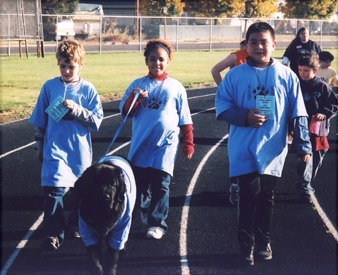
Ellie is always an
important contributor to the school’s fundraising events.
Ellie has had a profound effect on everyone she meets, but none
have been as deeply touched as Karen herself. A few years ago,
she was diagnosed with breast cancer. Throughout the many months
of treatments, Ellie was always at Karen’s side.
Chemotherapy is unbelievably debilitating. Karen often found that
she had difficulty getting up out of a chair or out of bed. All
on her own, knowing what was needed, Ellie would stand next to
Karen and hold rock-still, allowing Karen to pull herself to her
feet. After each chemotherapy treatment, Ellie would lie by
Karen’s bedside with her chin gently resting on the bed,
making sure Karen was okay. She instinctively knew that Karen
needed her there, and needed her to be quiet. And knowing that
Ellie needed her always gave Karen the reason to keep going.
Throughout the treatments, Karen continued to teach at school,
always with her Newfoundland by her side. Ellie not only provided
emotional support for the students at school, she faithfully
helped Karen through the most difficult months of her life.
Lindy Christopherson
Sweetbay’s Fisher, NF-9529, EL-3273
Mt. Vernon, Washington
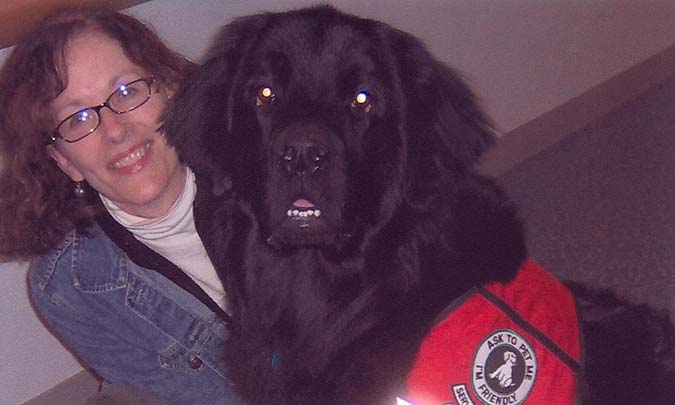
Lindy and Fisher
Lindy Christopherson’s husband John was diagnosed with a
chronic illness in 1999. The disease progressed fairly slowly at
first. But shortly after Sweetbay’s Fisher joined their
family in 2005, things went into overdrive. Walking became an
issue, and John had to employ a cane, and eventually a wheelchair
at one point. Bending over to pick something up was out of the
question. If John fell, he could not get up.
Lindy began training Fisher as John’s assistance dog from
puppyhood. There were no service-dog training classes in her
rural area, so Lindy made it up as she went along. As she says,
“Fortunately, Fisher is very bright and receptive, and he
made it all seem easy.”
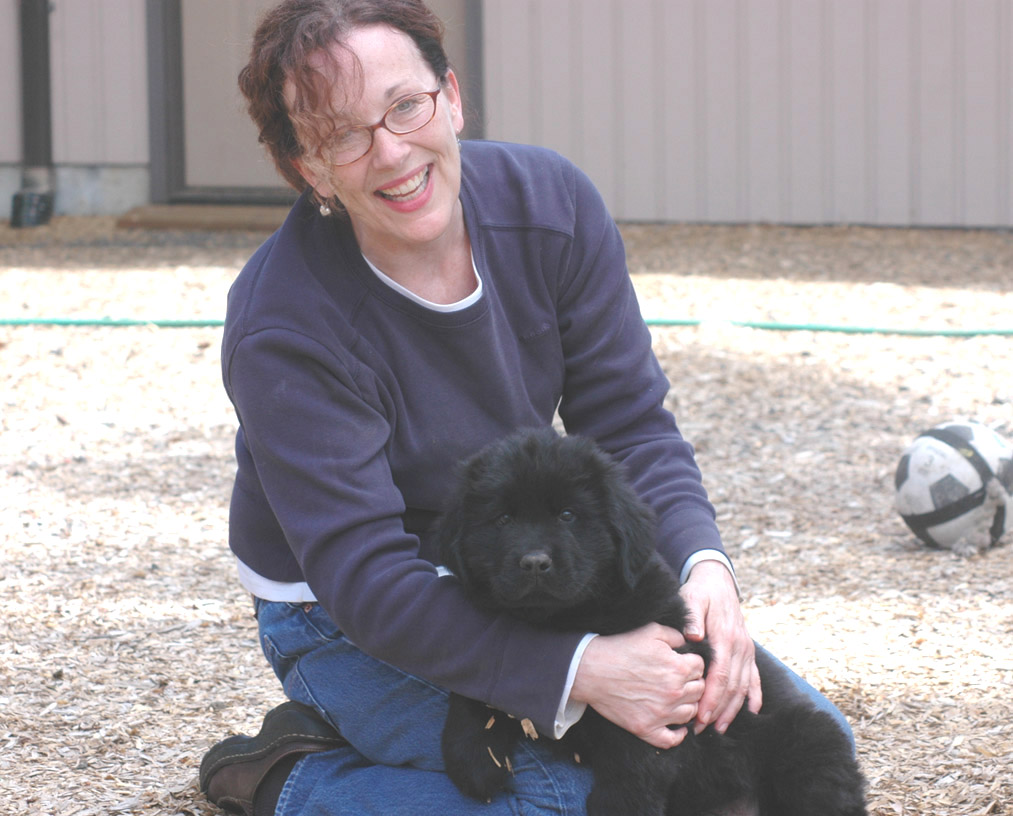
Lindy and eight week old Fisher
There were two primary tasks Fisher needed to learn. One was to
pick up any item and hold onto it until it was delivered. This is
akin to regular obedience training where the dog fetches and
delivers a dumbbell or a glove. But the objects Lindy
incorporated were of a much broader scope: socks, underwear,
towels, keys, the telephone, a toolbox, her purse, John’s
cane. Fisher learned quickly, and he became utterly reliable.
Lindy confesses that John isn’t the only one to value this
skill. She confides that it’s very handy to have a dog who
will pick up your keys when you are trying to unlock your front
door and you drop them, fumbling in the dark.
One of the more helpful “pick it up” tasks involved the
television remote control. It’s a common problem in many
households; the remote seems to have legs, and a mind of its own.
When Lindy tells Fisher that the remote has gone AWOL and sends
him to search, Fisher hunts diligently, going from room to room
if necessary, until he finds it. Then he brings it back and
inserts it into John’s hand.
The second crucial task was to stand absolutely steady so John
could use Fisher to get back on his (John’s) feet if he
fell. Although Lindy taught it with formal commands
(“stand” and “stay”), Fisher seemed to
understand what was needed even before she began the training. He
just planted his feet, stood like a rock, and would let her pull
herself up into a stand.
The Christophersons have been very lucky; John has been better
lately and has not needed Fisher’s services. But they still
ask Fisher daily to help out in the house by finding and bringing
items to them. He loves his job.
In 2009, Fisher passed a series of
certification tests with flying colors. This official stamp of
approval allows him to work with the public, sharing his gentle
sweetness and helpful nature on a broader scale. To Fisher, the
more he can do, the happier he is. Lindy says, “Some days I
feel like a soccer mom” as she drives the ultra-popular
Fisher to this event or that gathering.
Fisher participates in Tales for Tales, a program for second
graders who need extra help with reading skills. The children
read to dogs once a week, and the teachers cannot believe how
much having a dog in the classroom helps the slow readers make
progress. It makes sense, though. A dog is a safe, non-judgmental
listener. He doesn’t correct a kid’s pronunciation or
tell him to hurry. He never teases the kid if he makes a mistake,
and he is always supportive. Reading aloud is a valuable tool in
gaining proficiency, and reading to a dog removes the anxiety and
embarrassment. Lest you think this is drudgery for Fisher, Lindy
swears that he loves those visits. She says, “Fisher can
smell an elementary school a mile away. Maybe it's the cafeteria,
the milk, or the dirty feet - who knows? - but he loves those
places.”)
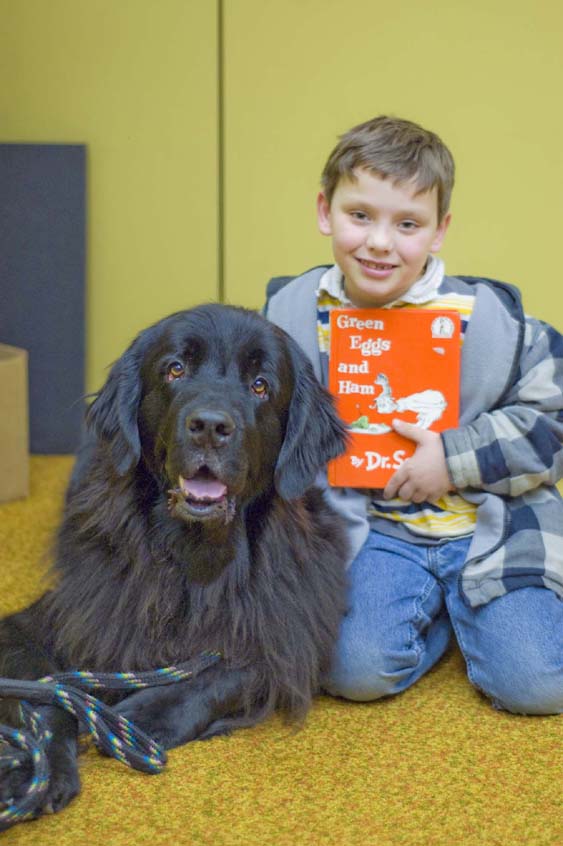
Young Caleb loves reading now. His skills improved
dramatically once Fisher began coming to the elementary school.
For ninety minutes, Fisher listens
patiently as one youngster or another sits at his side and reads
him pages from the books they’ve chosen. (Although Fisher
loves these sessions and listens intently, for some reason, Green
Eggs and Ham always put him to sleep.) When each group of
children graduate out of the sessions, Fisher is on hand to
congratulate them – with a cart ride.
In partnership with a ten-year-old golden retriever named Baker,
Fisher meets with large groups of children at a second elementary
school. The two dogs demonstrate the activities that service and
helper dogs do. To the kids, the tasks are all awe-inspiring
“tricks.” When Fisher unzips my coat, or shuts a
cupboard door, or hands me a crutch, or finds the remote that has
disappeared, the kids respond with “oohs” and
“aahs.” The real crowd-pleaser, though, is when Baker
does a little musical freestyle weaving, slipping in and out of
the much-taller Fisher’s legs. Public-relations programs
like this promote service dog work, an important part of ensuring
that service and helper dogs will continue to be an accepted part
of everyday life in a community.
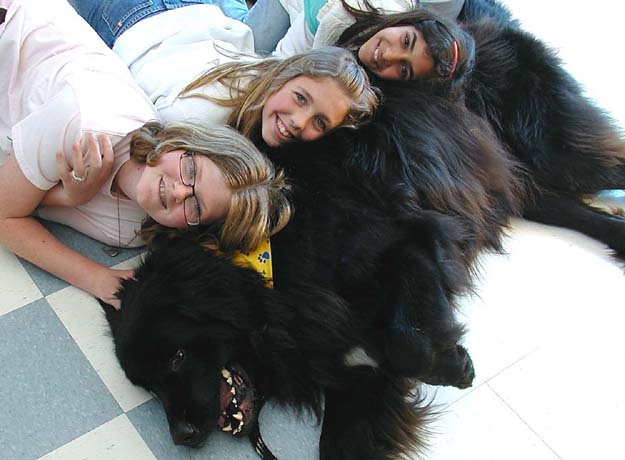
These three young ladies are volunteer “therapy
dog testers.” Through a program at their school, they create
situations a visiting dog might encounter: they yell and screech,
run through the halls, rush the dog to pet him, and so on. They
have worked with many potential therapy dogs, but Fisher was
their favorite from the moment they met.
Fisher’s schedule has
expanded to include nursing homes, rehab centers, and hospitals.
Wherever he goes, he is welcomed with broad smiles and open arms.
However, his most unusual assignment started with a simple
letter.
The programs coordinator for Skagit County’s juvenile
detention unit contacted Dogs on Call, the service dog group to
which Fisher belongs. This is a holding facility for ages twelve
to seventeen. The coordinator mentioned that many of the
“residents” had mental health issues, and all of them
were angry; no one wanted to be there. She felt that a visit from
a friendly dog could be a positive and welcome addition to their
unhappy lives. But – and this was crucial – it had to
be the right dog.
The Dogs on Call management recognized that this was a troubled
population. These weren’t smiling second graders. They were
enormous, fiercely muscled, heavily-tattooed, attitude-filled
young men (and a few women), nearly all aged fifteen to
seventeen. They may have been children according to the law, but
they looked and acted like full-grown men who felt no qualms
about breaking the law and were angry that they got caught. To be
effective, a dog would need to make an immediate and positive
impact on this group, plus be absolutely rock-solid in a
stressful and difficult environment. Finding the right match was
crucial. The service dog coordinator quickly narrowed the field
to one dog: “our gentle giant, the Newfoundland named
Fisher.”
Two months of meetings, correspondence, red tape, and background
checks ensued. One surprising issue surfaced almost immediately.
The list of what one can bring into the detention center is very
limited. No purses, nothing sharp, not even stapled sheets of
paper. Well, you can’t put on a demonstration without props.
This meant Lindy had to get specific permission for each item
Fisher uses in their repertoire, as well as those things he needs
for his own comfort.
Eventually, all the issues were resolved, and Fisher and Lindy
were set. Twice a month, on Saturdays, they would visit the
detention facility. Their regular appearances began in April.
Each time Lindy and Fisher arrive, Lindy is reminded that this is
a serious facility. They enter through a series of four
intimidating doors that are securely locked and under video
surveillance. The cafeteria, where Fisher does his show, is a
large open lunchroom area that’s surrounded by the locked
cells. Two armed guards are present in the room; a third watches
via surveillance camera. Lindy and Fisher take their positions in
the center, and each of the cell doors is unlocked, one by one.
(This session is not mandatory; the detainees can decide whether
to participate or not. Most can’t resist Fisher’s smile
and wagging tail.)
Lindy said, “When the young men file into the cafeteria,
they are all attitude, with fierce expressions and swaggering
gait. Then they see Fisher – and they light up like
three-year-olds at Christmas. Suddenly, they are kids again, and
for an hour, they forget where they are and just enjoy the
show.”
The average stay at the holding facility is under two weeks, so
there is a constant turnover. Each time, the audience is mostly
new. So Lindy begins each visit by introducing herself and her
furry companion. She talks about Newfoundlands and what they were
bred for, then shares Fisher’s weight (160), his height
(really tall!), and basic facts like what he likes to eat, and
how much. Invariably, someone asks where Newfoundland is, so a
free geography lesson is tossed in. Lindy also explains what
service and therapy dogs do.
Then she slips into Fisher’s repertoire, involving the
audience as much as she can. The idea of training a dog
fascinates these young men. Lindy demonstrates Fisher’s hand
signal commands, then lets volunteers take a turn giving Fisher a
command. Someone always tries “speak on command” –
and gets quite a surprise. Fisher has a massive, deep bark, and
he woofs right in the guy’s face at full volume. It’s
startling – and then everyone cracks up.
Lindy aims for as much lightness and levity as possible, yet she
also stresses the importance of these tasks. To a physically
compromised person, the dog’s skills are not entertaining.
They are invaluable. For instance, Lindy passes out socks and has
the young men put them on their feet; then Fisher goes from man
to man and pulls them off. Everyone laughs – but you can see
them thinking about why this might actually have a purpose.
At the end of the program, Fisher cruises the audience, eliciting
pets and scratches. For those moments, no one thinks of prison.
There’s just one happy dog and his many admirers, glorying
in each other’s company.